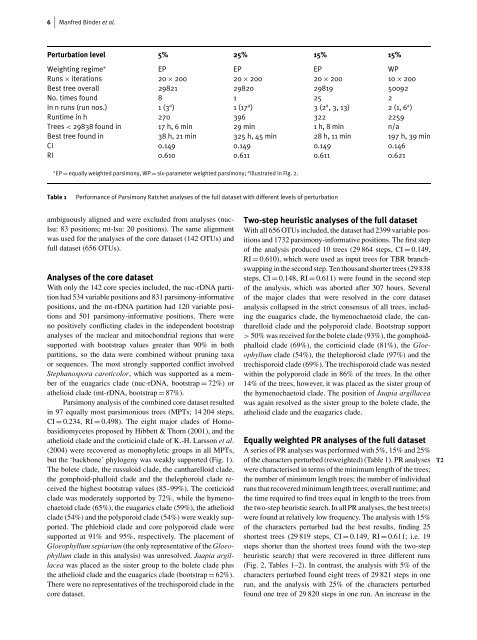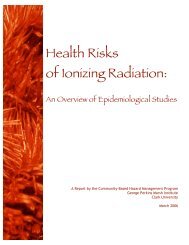The phylogenetic distribution of resupinate forms ... - Clark University
The phylogenetic distribution of resupinate forms ... - Clark University
The phylogenetic distribution of resupinate forms ... - Clark University
Create successful ePaper yourself
Turn your PDF publications into a flip-book with our unique Google optimized e-Paper software.
6 Manfred Binder et al.<br />
Perturbation level 5% 25% 15% 15%<br />
Weighting regime ∗ EP EP EP WP<br />
Runs × iterations 20 × 200 20 × 200 20 × 200 10 × 200<br />
Best tree overall 29821 29820 29819 50092<br />
No. times found 8 1 25 2<br />
In n runs (run nos.) 1 (3 a ) 1(17 a ) 3(2 a ,3,13) 2(1,6 a )<br />
Runtime in h 270 396 322 2259<br />
Trees < 29838 found in 17 h, 6 min 29 min 1 h, 8 min n/a<br />
Best tree found in 38 h, 21 min 325 h, 45 min 28 h, 11 min 197 h, 39 min<br />
CI 0.149 0.149 0.149 0.146<br />
RI 0.610 0.611 0.611 0.621<br />
∗ EP = equally weighted parsimony, WP = six-parameter weighted parsimony; a Illustrated in Fig. 2.<br />
Table 1 Performance <strong>of</strong> Parsimony Ratchet analyses <strong>of</strong> the full dataset with different levels <strong>of</strong> perturbation<br />
ambiguously aligned and were excluded from analyses (nuclsu:<br />
83 positions; mt-lsu: 20 positions). <strong>The</strong> same alignment<br />
was used for the analyses <strong>of</strong> the core dataset (142 OTUs) and<br />
full dataset (656 OTUs).<br />
Analyses <strong>of</strong> the core dataset<br />
With only the 142 core species included, the nuc-rDNA partition<br />
had 534 variable positions and 831 parsimony-informative<br />
positions, and the mt-rDNA partition had 120 variable positions<br />
and 501 parsimony-informative positions. <strong>The</strong>re were<br />
no positively conflicting clades in the independent bootstrap<br />
analyses <strong>of</strong> the nuclear and mitochondrial regions that were<br />
supported with bootstrap values greater than 90% in both<br />
partitions, so the data were combined without pruning taxa<br />
or sequences. <strong>The</strong> most strongly supported conflict involved<br />
Stephanospora caroticolor, which was supported as a member<br />
<strong>of</strong> the euagarics clade (nuc-rDNA, bootstrap = 72%) or<br />
athelioid clade (mt-rDNA, bootstrap = 87%).<br />
Parsimony analysis <strong>of</strong> the combined core dataset resulted<br />
in 97 equally most parsimonious trees (MPTs; 14 204 steps,<br />
CI = 0.234, RI = 0.498). <strong>The</strong> eight major clades <strong>of</strong> Homobasidiomycetes<br />
proposed by Hibbett & Thorn (2001), and the<br />
athelioid clade and the corticioid clade <strong>of</strong> K.-H. Larsson et al.<br />
(2004) were recovered as monophyletic groups in all MPTs,<br />
but the ‘backbone’ phylogeny was weakly supported (Fig. 1).<br />
<strong>The</strong> bolete clade, the russuloid clade, the cantharelloid clade,<br />
the gomphoid-phalloid clade and the thelephoroid clade received<br />
the highest bootstrap values (85–99%). <strong>The</strong> corticioid<br />
clade was moderately supported by 72%, while the hymenochaetoid<br />
clade (65%), the euagarics clade (59%), the athelioid<br />
clade (54%) and the polyporoid clade (54%) were weakly supported.<br />
<strong>The</strong> phlebioid clade and core polyporoid clade were<br />
supported at 91% and 95%, respectively. <strong>The</strong> placement <strong>of</strong><br />
Gloeophyllum sepiarium (the only representative <strong>of</strong> the Gloeophyllum<br />
clade in this analysis) was unresolved. Jaapia argillacea<br />
was placed as the sister group to the bolete clade plus<br />
the athelioid clade and the euagarics clade (bootstrap = 62%).<br />
<strong>The</strong>re were no representatives <strong>of</strong> the trechisporoid clade in the<br />
core dataset.<br />
Two-step heuristic analyses <strong>of</strong> the full dataset<br />
With all 656 OTUs included, the dataset had 2399 variable positions<br />
and 1732 parsimony-informative positions. <strong>The</strong> first step<br />
<strong>of</strong> the analysis produced 10 trees (29 864 steps, CI = 0.149,<br />
RI = 0.610), which were used as input trees for TBR branchswapping<br />
in the second step. Ten thousand shorter trees (29 838<br />
steps, CI = 0.148, RI = 0.611) were found in the second step<br />
<strong>of</strong> the analysis, which was aborted after 307 hours. Several<br />
<strong>of</strong> the major clades that were resolved in the core dataset<br />
analysis collapsed in the strict consensus <strong>of</strong> all trees, including<br />
the euagarics clade, the hymenochaetoid clade, the cantharelloid<br />
clade and the polyporoid clade. Bootstrap support<br />
> 50% was received for the bolete clade (93%), the gomphoidphalloid<br />
clade (69%), the corticioid clade (81%), the Gloeophyllum<br />
clade (54%), the thelephoroid clade (97%) and the<br />
trechisporoid clade (69%). <strong>The</strong> trechisporoid clade was nested<br />
within the polyporoid clade in 86% <strong>of</strong> the trees. In the other<br />
14% <strong>of</strong> the trees, however, it was placed as the sister group <strong>of</strong><br />
the hymenochaetoid clade. <strong>The</strong> position <strong>of</strong> Jaapia argillacea<br />
was again resolved as the sister group to the bolete clade, the<br />
athelioid clade and the euagarics clade.<br />
Equally weighted PR analyses <strong>of</strong> the full dataset<br />
A series <strong>of</strong> PR analyses was performed with 5%, 15% and 25%<br />
<strong>of</strong> the characters perturbed (reweighted) (Table 1). PR analyses T2<br />
were characterised in terms <strong>of</strong> the minimum length <strong>of</strong> the trees;<br />
the number <strong>of</strong> minimum length trees; the number <strong>of</strong> individual<br />
runs that recovered minimum length trees; overall runtime; and<br />
the time required to find trees equal in length to the trees from<br />
the two-step heuristic search. In all PR analyses, the best tree(s)<br />
were found at relatively low frequency. <strong>The</strong> analysis with 15%<br />
<strong>of</strong> the characters perturbed had the best results, finding 25<br />
shortest trees (29 819 steps, CI = 0.149, RI = 0.611; i.e. 19<br />
steps shorter than the shortest trees found with the two-step<br />
heuristic search) that were recovered in three different runs<br />
(Fig. 2, Tables 1–2). In contrast, the analysis with 5% <strong>of</strong> the<br />
characters perturbed found eight trees <strong>of</strong> 29 821 steps in one<br />
run, and the analysis with 25% <strong>of</strong> the characters perturbed<br />
found one tree <strong>of</strong> 29 820 steps in one run. An increase in the
















